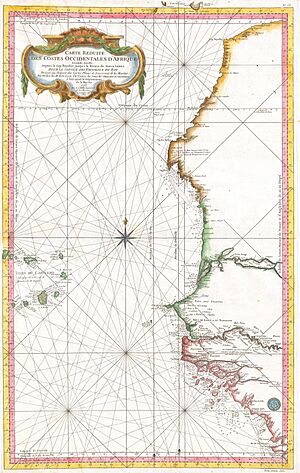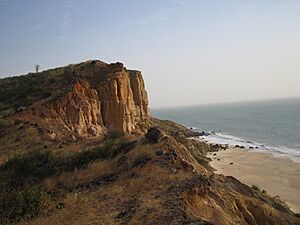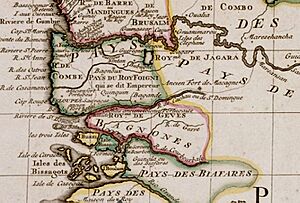Álvaro Fernandes facts for kids
Álvaro Fernandes was a brave Portuguese explorer from Madeira. He worked for Prince Henry the Navigator, a very important figure in Portuguese exploration. Álvaro Fernandes led two big trips in 1445 and 1446. These journeys helped Portugal discover more of the West African coast. He likely reached as far as what is now northern Guinea-Bissau. His farthest point, near Cape Roxo, remained the record for ten years. No one went further until Alvise Cadamosto in 1456.
Early Life
Álvaro Fernandes was the nephew of João Gonçalves Zarco. Zarco was famous for discovering and settling Funchal on Madeira. Álvaro grew up in the household of Prince Henry the Navigator. He served as a page or squire, learning important skills.
First Journey (1445)
In 1445, a group of small ships called caravels was prepared in Madeira. Two of these ships were set up by João Gonçalves Zarco. He chose his nephew, Álvaro Fernandes, to be the captain of one. Prince Henry himself gave special instructions to Álvaro. He told him to focus only on exploration and not to raid any villages.
Álvaro Fernandes sailed south, past the Arguin Bay area. He reached the mouth of the Sénégal River. He only stopped there to collect two barrels of river water.
He continued along the coast of Senegal to Cape Verde. This was the farthest point reached by another explorer, Dinis Dias. It's possible Álvaro Fernandes was the first European to sail around Cape Verde. He then entered the Angra de Bezeguiche (Bay of Dakar). Fernandes anchored at Gorée island. This island was empty of people but had many wild goats. His crew hunted these goats for food. Fernandes is said to have carved Prince Henry's motto, Talent de bien faire ("Hunger for good deeds"), on a tree there.
While they were near the island, some local canoes came out from the mainland. These were likely from the Wolof people or Lebou people. The first meeting was peaceful. Some locals were invited onto the ship and given food. Later, more canoes came. This time, Álvaro Fernandes decided to try and capture some people. He prepared a small boat with armed men. As the canoes got close, the Portuguese boat quickly moved out. The local people tried to swim back to shore. Two men were captured, but they fought hard. By the time the second man was caught, everyone else had escaped.
Since the surprise was gone, Álvaro Fernandes left the bay. He sailed south along the coast. He reached a tall cliff he named Cabo dos Mastos ("Cape of Masts"). This was because of dry tree trunks that looked like ship masts. Today, it's called Cape Naze. Fernandes sent a small boat to explore. They saw a group of four local hunters, possibly Serer people. The Portuguese tried to capture them, but the hunters ran away.
Álvaro Fernandes then returned to Portugal. He brought the two captured men, the river water, and the hunters' weapons. His actions had made the people around Bezeguiche bay wary. The next Portuguese ships to arrive there were met with arrows. For sailing further south than any other captain, Álvaro Fernandes and his uncle were well rewarded by Prince Henry.
Second Journey (1446)
The next year, Álvaro Fernandes set out again on a caravel. He sailed straight to his last point, Cabo dos Mastos. He landed a small group to explore, but they found no one. He continued sailing south. At one point, they saw a coastal village. A landing party went ashore but was met by armed local people, probably Serer people, defending their village. Álvaro Fernandes believed he killed the local leader, which made the other warriors pause. The Portuguese quickly returned to their ship.
The next day, the Portuguese captured two young local women gathering shellfish on the shore. The caravel sailed on until they reached a large river. This river was called "Rio Tabite" in old records. Álvaro Fernandes decided to send a small boat up the river to explore. The first boat landed near some huts and quickly captured a local woman. They brought her back to the caravel. Then, they went back to explore further upriver. But they soon saw four or five canoes with armed men coming towards them. Fernandes immediately turned his boat around and raced back to the caravel. One canoe almost caught up. Fernandes prepared to fight, but the lead canoe slowed down to wait for the others. This gave the Portuguese boat time to escape. Álvaro Fernandes was badly hurt in the leg by an arrow from one of the canoes. He disinfected the wound and was very sick for a few days, but he recovered.
Despite this dangerous experience, the caravel continued south for a short time. They reached a sandy cape and a large sandy bay. A small boat went to explore near the beach. They saw about 120 local people, armed with shields and bows, walking towards them. The explorers quickly returned to the caravel. The armed group on the beach seemed to make peaceful gestures, inviting the Portuguese to land. But because Fernandes was still recovering and they had just escaped danger, they decided to leave and sail back to Portugal.
On the way home, Fernandes stopped at Arguin island. There, they traded for a local woman with some Berber traders. When he arrived in Portugal, Álvaro Fernandes was greatly rewarded. Prince Henry gave him 100 gold coins, and the regent, Peter of Coimbra, gave him another 100. This was because he had sailed further than any other Portuguese captain at that time.
How Far Did He Go?
Álvaro Fernandes pushed the limits of Portuguese exploration the most in the 1440s. On his first trip in 1445, he was almost certainly the first European to land on Gorée island. He sailed as far as Cape Naze in central Senegal.
How far he went on his second journey in 1446 is less clear. Some old records say he sailed very far, possibly reaching modern Guinea. However, many historians today think these records exaggerated. It's unlikely he would have sailed past big rivers and islands without mentioning them.
Most modern historians believe the river he explored, "Rio Tabite," was probably the Casamance River in Senegal. They think his final point was around Cape Varela, just below Cape Roxo, in what is now northern Guinea-Bissau. This means he sailed about 50 leagues (not 110) beyond Cape Vert. Even so, this was the farthest point reached by Portuguese explorers in the 1440s.
There's some debate about the arrow that hit him. Some historians wonder if it was truly poisoned, as he survived. Other explorers who were hit by poisoned arrows died quickly. The fact that he survived suggests it might have been a regular arrow that got infected.
Álvaro Fernandes did not give names to the places he discovered on his second journey. The old records also use vague terms like "some days" or "a certain distance." This makes it hard to know his exact route. But it is clear that he sailed further than anyone before him in 1446. His record stood for ten years. It was finally broken in 1456 by Alvise Cadamosto, an explorer from Venice who also worked for Prince Henry. Cadamosto later claimed to have discovered the Casamance River.
Sources
- João de Barros (1552) Décadas da Ásia: Dos feitos, que os Portuguezes fizeram no descubrimento, e conquista, dos mares, e terras do Oriente.. Vol. 1 (Dec I, Lib.1-5).
- Gomes Eanes de Zurara (1453) Crónica dos feitos notáveis que se passaram na Conquista da Guiné por mandado do Infante D. Henrique or Chronica do descobrimento e conquista da Guiné. (Trans. 1896–99 by C.R. Beazley and E. Prestage), The Chronicle of the Discovery and Conquest of Guinea, London: Halyut, v.1, v.2
- Beazley, C.R. and E. Prestage (1896–99) "Introduction" & "Notes" in English translation of Zurara's Chronicle.
- Castilho, A.M. de (1866) Descripção e roteiro da costa occidental de Africa, desde o cabo de Espartel até o das Agulhas, Lisbon: Impresa Nacional, 2 vols.
- Cortesão, Armando (1931) "Subsídios para a história do Descobrimento de Cabo Verde e Guiné", Boletim da Agencia Geral das Colonias, No. 75. As reprinted in 1975, Esparsos, vol. 1, Coimbra. online
- Diffie, Bailey W., and George D. Winius (1977) Foundations of the Portuguese empire, 1415–1580 Minneapolis, MN: University of Minnesota Press
- Manuel de Faria e Sousa (1675) ""Empieça la Memoria de todas las Armadas", in Asia Portuguesa, Vol. 3, p.525-61
- Diogo Gomes De prima inventione Guineae (Portuguese translation by Gabriel Pereira (1898–99) as "As Relações do Descobrimento da Guiné e das ilhas dos Açores, Madeira e Cabo Verde" in Boletim da Sociedade de Geografia de Lisboa, no. 5 online)
- Leite, Duarte (1941) Acerca da «Crónica dos Feitos de Guinee». Lisbon: Bertrand
- Magalhães Godinho, Vitorino de (1945) Documentos sôbre a Espansão Portuguesa, 2 vols, Lisbon: Gleba.
- Peres, Damião (1943) História dos descobrimentos portugueses, Porto: Portucalense.
- Quintella, Ignaco da Costa (1839–40) Annaes da Marinha Portugueza, 2 vols, Lisbon: Academia Real das Sciencias. vol. 1
- Teixeira da Mota, Avelino (1946) "A descoberta da Guiné", Boletim cultural da Guiné Portuguesa, Vol. 1. Part 1 in No. 1 (Jan), p. 11-68, Pt. 2 in No. 2 (Apr), p. 273-326; Pt. 3 in No. 3 (Jul), p. 457-509.
- Teixeira da Mota, Avelino (1972) Mar, além Mar: Estudos e ensaios de história e geographia. Lisbon: Junta de Investigações do Ultramar
See Also
 In Spanish: Álvaro Fernandes para niños
In Spanish: Álvaro Fernandes para niños




